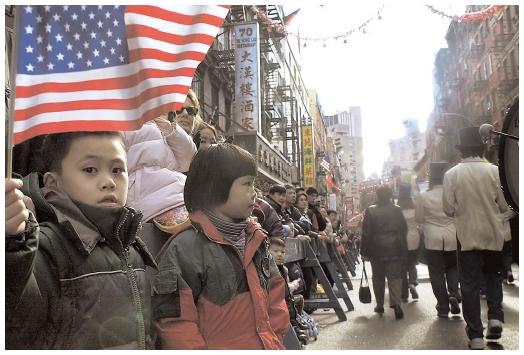
I was born in China and spent most of my formulative years there. I cannot say that I developed my Asian racial identity in China because my identity was very much innate and blanketed by my physical surroundings. Cross' Racial Identity Development Model seems to be grounded on the notion that systemic or environmental factors cause an individual to feel “different.” I do not recall many situations where I had to exert my racial identity; everyone I interacted with during these years were Chinese. There was not another skin color I could compare to. Growing up in a very homogeneous population of working class Chinese folks in rural China and then urban Hong Kong taught me very little about racial and cultural identity. While racial homogeneity may lead to racial isolation, I found my experiences to be very positive. Back then, I did not know about racism; I transcended the issue of race by considering people as individuals rather than markers of their racial categories. The Cross Model, and other identity models, cannot generalize all individuals within a specified group, e.g. immigrants versus native-born, adults versus adolescents, but it is helpful in that it considers the sociopolitical influences on individuals.
Coming to the United States, I was confronted with a melting pot of diversity. On the upside, I gained exposure to difference and hopefully, learned to immerse in it and embrace it. However, I also learned to set categorical cultural and racial frames around certain people. I learned to discriminate. The U.S., because of its sheer diversity, fosters an oppressive culture where those who are “different” from the norm (white, homosexual male) are discriminated against. In this environment, those who are "different" internalize the messages they have been fed about what is “right” and “normal” to develop a heightened sense of self and group identity. Cross's model shows the “resocialization experience” in which a Black individual progresses from a non-Afrocentric to an Afrocentric to a multicultural identity. During this transformation, the individual ideally progresses from a complete oblivion to race then to embracing black culture exclusively and finally settling on a commitment to embrace all races and cultures. The model ends with an integrated sense of self awareness.
I followed this framework of racial transformation very squarely in America. I was fed with images of white superiority and power in this country. The low-income neighborhoods in Boston comprise mostly of minorities. The wealthier parts of Boston were predominantly white. In the media, I saw colorized images depicting racial discrepancies in crime versus honorable popularity. In my preencounter stage of racial identity formation, I respected the dominant racial culture, white culture, highly. I tried to assimilate to reap the benefits that come with being white. I surrounded myself with white popular culture, made white friends, ate Western food, dressed more Western, and behaved in a more American fashion. I am not implying that assimilation is reprobate or white culture is abominable. However, in retrospect, I did not give much credit to my own culture and did not have much racial pride, despite the countless achievements that Asian Americans have achieved in this country.
My token sense of racial pride also stemmed from the fact that I was an immigrant. As an immigrant coming from an impoverished background in China, my expectations coming to America were simple: work hard in school, get a good job, and repay my parents. My priorities were focused on education and family life; I did not care much about anything else. When I was discriminated, and I do clearly remember being discriminated many times, I brushed it off and pretended like nothing happened. I did not expect to be treated equally or with respect. I only expected to be treated better than I was treated back in China. Under an oppressive political climate and living in substandard conditions, life in America was milestones more viable. Because I felt less swayed by negative racial stereotypes portend a diminution in Asian Americans racial group identity and a gradual assimilation into mainstream, white America.
The Cross racial identity model discusses an intersection between racial perceptions of others (racism) and racial perception of self (racial development). Although our perceptions of others are important and act as triggers for development and consciousness, there is great value in the consideration of racial and ethnic identity for oneself and groups of individuals. When I first entered the US, not knowing any English and being socially reserved, I found an unchallenged notion to be happy with my lot. Although I lived in a white blue-collar neighborhood in Boston and was a target of racial intolerance, battered with verbal abuse and jeering glances, I did not stand up for myself, my culture, my race. However, as I improved on my English and matured physically and mentally, I grew out of my reclusive shell and one day, decided to confront a few teenagers who were throwing racial slurs at me. Looking them in the eye, I simply but affirmatively told them to stop, in clear articulate English. To my relief, the same kids never pestered me again. Had I not stayed there to confront my oppressors, I would regrettably remain a reticent victim of racial injustice. This experience resonates with that typical in the encounter stage.
Racial identity is a situational construct evolved over time. Because of competition and conflict with other groups, heightened racial identity based on group solidarity and similarity of experiences might form. My racial identity emerged out of the aforementioned incident, aligning with the immersion/emersion phase of the racial identity development spectrum. However, I gradually grasped that Americans are diverse, some are discriminated, others are the oppressors. America, itself, is not a country on an island in and of itself. Racial conflicts all across the world reveal the challenges we need to overcome to build cohesive, tolerant, and multicultural societies. I learn from my own experiences the injustice that plagues our society but I also learn the power of activism and speaking out. I try to promote my dream of a tolerant multicultural society by appreciating all people. As hostess of the local Boston show “Girl TV”, I often shared how I felt growing up and being discriminated. I encouraged the show’s viewers to stand up for who they are. Every time I received appreciative letters or calls from viewers, I feel even more committed to my dream. Overcoming my experiences with racial discrimination has provoked me to help others accomplish the same. I hope that those who are victims will work to have their voices heard and those who discriminate against others will learn to stop and understand. In this manner, I have satisfactorily internalized my racial pride with a greater sense of community and made a commitment that transcends the self to the group and beyond.






